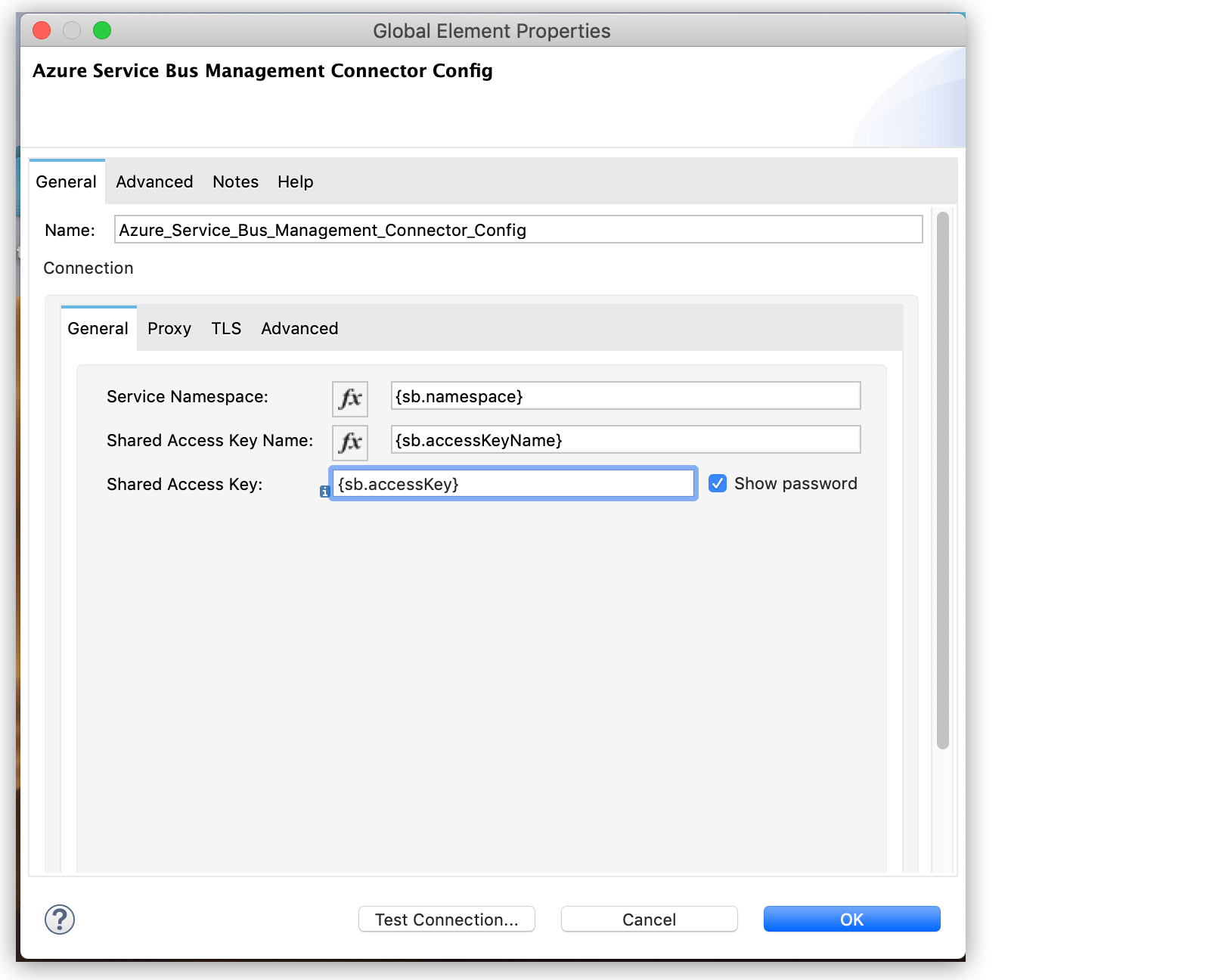Namespace for the Azure Service Bus Service within your subscription
Using Anypoint Studio to Configure Azure Service Bus Management 1.0
Anypoint Studio (Studio) editors help you design and update your Mule applications, properties, and configuration files.
To add and configure a connector in Studio:
When you run the connector, you can view the app log, as described in View the App Log.
If you are new to configuring connectors in Studio, see Using Anypoint Studio to Configure a Connector. If, after reading this topic, you need additional information about the connector fields, see the Azure Service Bus Management Reference.
Create a Mule Project
In Studio, create a new Mule project in which to add and configure the connector:
-
In Studio, select File > New > Mule Project.
-
Enter a name for your Mule project and click Finish.
Add the Connector to Your Mule Project
Add Anypoint Connector for Azure Service Bus Management (Azure Service Bus Management Connector) to your Mule project to automatically populate the XML code with the connector’s namespace and schema location and add the required dependencies to the project’s pom.xml file:
-
In the Mule Palette view, click (X) Search in Exchange.
-
In Add Modules to Project, type
azurein the search field. -
Click Azure Service Bus Management in Available modules.
-
Click Add.
-
Click Finish.
Adding a connector to a Mule project in Studio does not make that connector available to other projects in your Studio workspace.
Configure an Input Source
An input source initiates a flow when a specified condition is met. You can configure one of these input sources to use with Azure Service Bus Management Connector:
-
HTTP Listener, which initiates a flow each time it receives a request on the configured host and port -
Scheduler, which initiates a flow when a time-based condition is met
For example, to configure HTTP Listener, follow these steps:
-
In the Mule Palette view, select HTTP > Listener.
-
Drag Listener to the Studio canvas.
-
On the Listener configuration screen, optionally change the value of the Display Name field.
-
Specify a value for the Path field.
-
Click the plus sign (+) next to the Connector configuration field to configure a global element that can be used by all instances of
HTTP Listenerin the app. -
On the General tab, specify connection information.
-
On the TLS tab, optionally specify TLS information.
-
On the Advanced tab, optionally specify reconnection information, including a reconnection strategy.
-
Click Test Connection to confirm that Mule can connect with the specific server.
-
Click OK.
Add a Connector Operation to the Flow
When you add a connector operation to your flow, you immediately define a specific operation for that connector to perform.
To add an operation for Azure Service Bus Management Connector, follow these steps:
-
In the Mule Palette view, select Azure Service Bus Management and then select the desired operation.
-
Drag the operation onto the Studio canvas to the right of the input source.
Configure a Global Element for the Connector
When you configure a connector, it’s best to configure a global element that all instances of that connector in the app can use. Configuring a global element requires you to provide the authentication credentials the connector uses to access the target Azure Service Bus instance. Azure Service Bus Management Connector supports shared access signature (SAS) authentication.
To configure the global element for Azure Service Bus Management Connector, follow these steps:
-
Select the name of the connector in the Studio canvas.
-
In the configuration screen for the operation, click the plus sign (+) next to the Connector configuration field to access the global element configuration fields.
-
On the General tab, configure shared access signature (SAS) authentication by entering values for these fields:
Field User Action Service Namespace
Shared Access Key Name
Name of your SAS token
Shared Access Key
SAS token
The following screenshot shows an example of configuring shared access signature (SAS) authentication. This screenshot uses property placeholders for field values. For information about using property placeholders, see Anypoint Connector Configuration.
 Figure 1. SAS authentication fields
Figure 1. SAS authentication fields -
On the Advanced tab, optionally specify reconnection information, including a reconnection strategy.
-
Click Test Connection to confirm that Mule can connect with the specified server.
-
Click OK.
Configure the Other Connector Fields
After you configure a global element for Azure Service Bus Management Connector, configure the other required fields for the connector operation.
For example, to create or update a queue or topic, use the Create or Update Entity operation and complete these fields:
| Field | Description |
|---|---|
Entity (Queue or Topic) |
Enter the name of the entity to create or update. |
If Match |
To update an existing entity, set this header to |
Content |
Enter the queue description or topic. |
View the App Log
You can view the app log as follows:
-
If you’re running the app from Anypoint Platform, the output is visible in the Anypoint Studio console window.
-
If you’re running the app using Mule from the command line, the app log is visible in your OS console. Unless the log file path was customized in the app’s log file (
log4j2.xml), you can also view the app log in this default location:MULE_HOME/logs/<app-name>.logFor more information about the app log, see Configuring Logging.
Next Step
See Additional Configuration Information for more configuration information.



